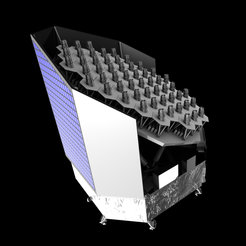Stellar inventory: Searching for other Earths
ESA has given the official go-ahead for the planet-hunting and asteroseismology space mission PLATO. The mission’s data center will be established at the MPS.
How common are worlds like ours and are they suitable for the development of life? Scheduled for launch in 2024, the European Space Agency’s (ESA) new planet-hunting mission PLATO (PLAnetary Transits and Oscillations of stars) will take an unprecedented step towards answering these questions. Today, ESA announced the official selection of PLATO as its next medium-class space mission. In its six year lifetime, the spacecraft will search for planets around one million stars; of these 85000 will be characterized precisely. In close collaboration with many European partners Germany will play a key role in the mission: the German Aerospace Center (DLR) in Berlin will head the overall mission; the Max Planck Institute for Solar System Research (MPS) in Göttingen will lead the processing of the observations in the PLATO Data Center.

“PLATO will discover planets like our own, capable of harboring life”, says Prof. Dr. Laurent Gizon, Director at the MPS. Exoplanet science has made tremendous progress in recent years thanks to the CoRoT mission of ESA/CNES and NASA’s Kepler mission. However, these pioneering missions were not designed to detect new worlds orbiting near-by stars. PLATO will for the first time fully characterize these stars and their planets. The ultimate goal of the mission is to find an Earth-twin: “PLATO will enable us to find planets that orbit their star in the habitable zone: planets where liquid water is expected, and where life as we know it can be maintained”, says Dr. Heike Rauer from DLR, who will lead the mission.
In order to reach this ambitious goal, PLATO is equipped not with one, but with an array of 34 telescopes mounted on a single satellite. By surveying a very large fraction of the sky for six years, PLATO will study the full diversity of stars and planetary systems across our galaxy. “PLATO will finally give us the big picture”, says Gizon.
When an exoplanet passes in front of its host star, the starlight is slightly dimmed. PLATO will detect such planetary transits and characterize thousands of rocky planets (including Earth twins) as well as icy or giant planets by providing exquisite measurements of their radii, masses, and ages. In order to determine the properties of the planets, it is essential to know the radii, masses, and ages of their host stars. Only asteroseismology, the study of stellar oscillations, can provide the level of accuracy that is needed.

In the years prior to launch, the MPS will establish the PLATO Data Centre, which will coordinate with other PLATO Data Processing Centers across Europe. Housed in the brand new building of the MPS on the Göttingen University Campus, the PLATO Data Center will process one million stellar light curves to generate the final scientific data products: the radii, masses, and ages of confirmed planets. “The PLATO catalogue will be a treasure for generations of astronomers to come. It will contain prized targets for the search for life outside our solar system”, says Gizon.

